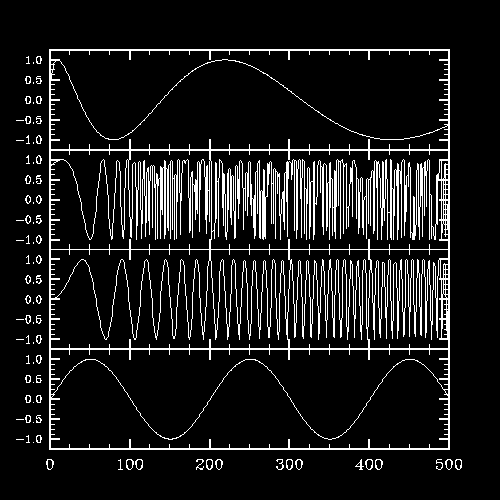XyPlot example 15


This example is created using HLU C library calls, HLU FORTRAN library
calls, or NCL. It demonstrates how to create a set of four "stacked"
XyPlots and how to use annotations to simplify the control and sizing
of all the plots. The names of the source files for this example are
xy15c.c, xy15f.f, and xy15n.ncl.

Discussion
This module discusses how to create this plot using HLU function calls
or NCL. The resource file used with this example is called xy15.res.
This example illustrates the creation of a set of four "stacked"
XyPlots. Each plot has the same X axis. By making the top three plots
into annotations of the bottom plot, all four plots can be manipulated
as a unit. To demonstrate this concept, the second frame sets the
viewport of the base plot. Because all the annotations have their
"amResizeNotify" resource set to True (in the resource file), all the
annotation plots resize themselves proportionally to the change in the
size of the base plot. Each plot draws a variation of a sinusoidal
curve.
A more detailed discussion of how this example works appears in its source
code.
The HLU C program that generates this plot is called
xy15c.c.
The HLU FORTRAN program that generates this plot is called
xy15f.f.
The NCL script that generates this plot is called
xy15n.ncl.
The data for this plot is generated from within the HLU program.
The examples are installed in the following locations:
- $NCARG_LIB/ncarg/hluex/xyplot/xy15c.c
- $NCARG_LIB/ncarg/hluex/xyplot/xy15f.f
- $NCARG_LIB/ncarg/nclex/xyplot/xy15n.ncl
The resource file for this example is located in:
- $NCARG_LIB/ncarg/resfiles/xyplot/xy15.res
You can copy this example and run it by typing "ng4ex xy15c", "ng4ex
xy15f", or "ng4ex xy15n". A copy of the source file will be placed in
your current working directory. The source code will be compiled and
automatically run for you.
Quick Start Guide Control Panel
NG4.1 Home, Index, Examples, Glossary, Feedback, QSG Contents, QSG WhereAmI?
$Revision: 1.9 $ $Date: 1999/03/23 21:15:25 $

